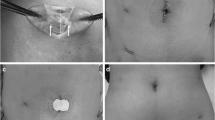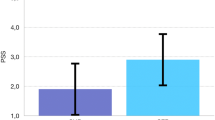Summary
Background
The use of 2‑octyl cyanoacrylate (CA) for the umbilical wound after single-incision laparoscopic surgery (SILS) for colorectal cancer has not been described.
Methods
A consecutive experience of SILS for colorectal cancer is presented. Three hundred sixty-four patients (172 women) were treated with SILS for colorectal cancer between December 2010 and December 2015. Our institution introduced CA in September 2012. The data of patients treated with CA were compared to a historical group who underwent standard sutured skin closure with thin adhesive strips (AS) at our institution. The Centers for Disease Control and Prevention criteria were used for the diagnosis of superficial surgical site infection (SSI).
Results
Of these 364 patients, 20 patients (5.5%) were converted to laparotomy including the extension of the skin incision longer than 3 cm. In 344 patients completed with SILS, CA was used in 247 patients. Superficial SSI occurred in two patients (0.81%) with CA and one (1.03%) with AS. No patients completed with SILS suffered wound dehiscence in this series. There were no significant differences in wound-related complication rate between the two groups.
Conclusions
CA provides sufficient wound closure in SILS for colorectal cancer. SILS with CA has the possibility to provide a lower superficial SSI rate in patients with colorectal cancer.

Similar content being viewed by others

References
Tang R, Chen HH, Wang YL, Changchien CR, Chen JS, Hsu KC, Chiang JM, Wang JY. Risk factors for surgical site infection after elective resection of the colon and rectum: a single-center prospective study of 2809 consecutive patients. Ann Surg. 2001;234:181–9.
Itani KM, Wilson SE, Awad SS, Jensen EH, Finn TS, Abramson MA. Ertapenem versus cefotetan prophylaxis in elective colorectal surgery. N Engl J Med. 2006;355:2640–51.
Chow A, Marshall H, Zacharakis E, Paraskeva P, Purkayastha S. Use of tissue glue for surgical incision closure: a systematic review and meta-analysis of randomized controlled trials. J Am Coll Surg. 2010;211:114–25.
Tajirian AL, Goldberg DJ. A review of sutures and other skin closure materials. J Cosmet Laser Ther. 2010;12:296–302.
Watanabe T, Itabashi M, Shimada Y, Tanaka S, Ito Y, Ajioka Y, Hamaguchi T, Hyodo I, Igarashi M, Ishida H, Ishihara S, Ishiguro M, Kanemitsu Y, Kokudo N, Muro K, Ochiai A, Oguchi M, Ohkura Y, Saito Y, Sakai Y, Ueno H, Yoshino T, Boku N, Fujimori T, Koinuma N, Morita T, Nishimura G, Sakata Y, Takahashi K, Tsuruta O, Yamaguchi T, Yoshida M, Yamaguchi N, Kotake K, Sugihara K, Japanese Society for Cancer of the Colon and Rectum. Japanese Society for Cancer of the Colon and Rectum (JSCCR) guidelines 2014 for treatment of colorectal cancer. Int J Clin Oncol. 2015;20:207–39.
Farion K, Osmond MH, Hartling L, Russell K, Klassen T, Crumley E, Wiebe N. Tissue adhesives for traumatic lacerations in children and adults. Cochrane Database Syst Rev. 2002; https://doi.org/10.1002/14651858.cd003326.
Collin TW, Blyth K, Hodgkinson PD. Cleft lip repair without suture removal. J Plast Reconstr Aesthet Surg. 2009;62:1161–5.
Cho J, Harrop J, Veznadaroglu E, Andrews DW. Concomitant use of computer image guidance, linear or sigmoid incisions after minimal shave, and liquid wound dressing with 2‑octyl cyanoacrylate for tumor craniotomy or craniectomy: analysis of 225 consecutive surgical cases with antecedent historical control at one institution. Neurosurgery. 2003;52:832–40.
Lee KW, Sherwin T, Won DJ. An alternate technique to close neurosurgical incisions using octyl cyanoacrylate tissue adhesive. Pediatr Neurosurg. 1999;31:110–4.
Leung GY, Peponis V, Varnell ED, Lam DS, Kaufman HE. Preliminary in vitro evaluation of 2‑octyl cyanoacrylate (Dermabond) to seal corneal incisions. Cornea. 2005;24:998–9.
Lee J, Singletary R, Schmader K, Anderson DJ, Bolognesi M, Kaye KS. Surgical site infection in the elderly following orthopaedic surgery. Risk factors and outcomes. J Bone Joint Surg Am. 2006;88:1705–12.
Scott GR, Carson CL, Borah GL. Dermabond skin closures for bilateral reduction mammaplasties: a review of 255 consecutive cases. Plast Reconstr Surg. 2007;120:1460–5.
Wilson AD, Mercer N. Use of Dermabond in cleft lip repair. J Plast Reconstr Aesthet Surg. 2010;63:1064–5.
Quinn JV, Osmond MH, Yurack JA, Moir PJ. N‑2 butyl cyanoacrylate: risk of bacterial contamination with an appraisal of its antimicrobial effects. J Emerg Med. 1995;13:581–5.
Bhende S, Rothenburger S, Spangler DJ, Dito M. In vitro assessment of microbial barrier properties of Dermabond topical skin adhesive. Surg Infect (Larchmt). 2002;3:251–7.
Esemuede IO, Gabre-Kidan A, Fowler DL, Kiran RP. Risk of readmission after laparoscopic vs. open colorectal surgery. Int J Colorectal Dis. 2015;30:1489–94.
Author information
Authors and Affiliations
Corresponding author
Ethics declarations
Conflict of interest
Y. Hirano, C. Hiranuma, K. Douden, and M. Hattori declare that they have no competing interests.
Ethical standards
All procedures performed in studies involving human participants were in accordance with the ethical standards of the institutional and/or national research committee and with the 1975 Helsinki declaration and its later amendments or comparable ethical standards. Informed consent was obtained from all individual participants included in the study.
Rights and permissions
About this article
Cite this article
Hirano, Y., Hiranuma, C., Douden, K. et al. Wound closing method with 2‑octyl cyanoacrylate after single-incision laparoscopic surgery for colorectal cancer. Eur Surg 51, 27–30 (2019). https://doi.org/10.1007/s10353-018-0562-9
Received:
Accepted:
Published:
Issue Date:
DOI: https://doi.org/10.1007/s10353-018-0562-9



